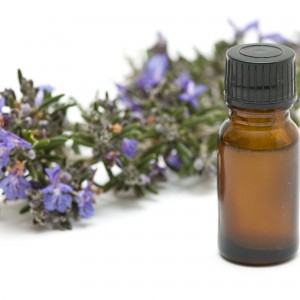Essential Oils, Glandular Trichomes and the Secondary Metabolism
 The essential oil industry is a billion dollar a year business that does not show any signs of slowing down. Essential oils derived from plants including, but not nearly limited to, mint, basil and thyme are key ingredients in products such as medicines/remedies, aromatic fragrances and flavorings. The demand for these products has been the driving force behind countless research studies conducted with the goal of understanding how and why plants produce these unique chemical compounds and, perhaps of more importance, how growers can significantly enhance or increase the production of said compounds. The research really begins at the apex of essential oil production, the glandular trichome.
The essential oil industry is a billion dollar a year business that does not show any signs of slowing down. Essential oils derived from plants including, but not nearly limited to, mint, basil and thyme are key ingredients in products such as medicines/remedies, aromatic fragrances and flavorings. The demand for these products has been the driving force behind countless research studies conducted with the goal of understanding how and why plants produce these unique chemical compounds and, perhaps of more importance, how growers can significantly enhance or increase the production of said compounds. The research really begins at the apex of essential oil production, the glandular trichome.
Glandular trichomes are best described as tiny, specialized hair-like formations found on the epidermis of plant stems and leaves. At the tip of the hairs are glandular cells that produce, store and eventually, secrete trichome exudates such as essential oils. Nearly all plant species produce some sort of hair-like formation, but only about 30% of vascular plants are equipped with the ability to create these sought after substances known as secondary metabolites. Glandular trichomes come in several different shapes, which are highly species-specific, to the point where they are often a plant characteristic used in the classification and identification of a plant species. Glandular trichomes are not directly connected to a plant’s vascular system and, therefore, are not products of a plants primary metabolism (which will be discussed further on). The production and secretion of essential oils and other secondary metabolites, though highly commercialized for things like aromas and medicines, is believed to be an evolutionary response to external stresses in the surrounding environment, a protective measure of sorts. In order to understand what secondary metabolites are one must first address what they are and why they are produced.
To begin, primary metabolites, produced by the primary metabolism, are compounds that play an important role in basic life functions such as respiration, reproduction, cell division and growth, which are all essential processes that allow plants to properly complete their full growth cycle. Secondary metabolite compounds (such as glandular trichomes) are not directly involved in these types of plant-life functions, but they do serve an important purpose. Secondary metabolites are believed to play a major role in a plant’s ability to adapt to the dangers of their environment. These compounds provide a level of defense against possible antagonists in the surrounding areas as they exhibit properties such as antifungal, antibiotic and antiviral. These properties are the reason the compounds are sought after for medicinal purposes. Not only do secondary metabolites aid in protection from microscopic assailants, they also help protect plants from various insects and animals (some of the compounds secreted can cause severe discomfort when ingested). In addition, they also contain UV ray absorbing compounds that protect the leaves from potential harm from the light. Through evolution, plants began to create several different types of secondary metabolites as means of protection from a vast array of predators and stresses. One of the formations formed for storage and secretion of the secondary metabolites is the glandular trichome. For years, scientists have been working on ways to increase glandular trichome production in numerous plant species in an effort to collect as much of the desired essential oils as is physically possible from a single plant. The question is: if glandular trichomes are the result of a plant’s protective measure against a danger in the environment, how do we simulate the stress and the production of glandular trichome on our plants at home (especially, those grown in controlled environments)?
Basically, a plant’s glandular trichome production potential is the result of genetics developed through interaction with its surrounding environment. Plants that evolved in a more threatening environment, with a high potential for attack by disease or insects, generally have a higher level of glandular trichome production. But this does not mean that, through certain stimuli, production levels cannot be increased. To be clear, I would never suggest releasing harmful pests into a controlled growing environment, but there are measures that can be taken to cause physical stress to a plant without greatly harming the growth cycle. Older leaves and branches can be cut to make the plant think that it is under attack from some type of herbivore type of predator. Growers can also supplement with artificial UV-A or UV-B lighting in an effort to create environmental stress, which could possibly induce higher production levels of glandular trichomes. There are also several fertilizer supplement products that are marketed by their ability to enhance glandular trichome production. I have used a few on my culinary herb garden and have had satisfactory results, however, judging by the product labels, it is hard to pinpoint the active ingredient that provides such results. Studies have shown that the naturally occurring plant hormone Jasmonate plays an important role in triggering the pathways that create secondary metabolites. In a lab, scientists have figured out how to create a synthetic version of the hormone, which is called Jasmonic acid. However, a grower should show due diligence and research any possible harms when considering using a growth-regulating hormone of any type. This is of utmost importance if the plant is intended for eventual human consumption.
Glandular trichomes are an excellent example of the deeply rooted, complex relationship shared between humans and plants. These secondary metabolites are the product of a plant striving to survive in an unforgiving environment. To us, however, they represent so much more. Though we do utilize them for their beneficial medicinal properties, we also regale them for their flavors and aromas. Substances created within glandular trichomes enhance our daily lives and prove that, no matter what, we are still strongly attached to the plants we grow and the nature that surrounds us.


